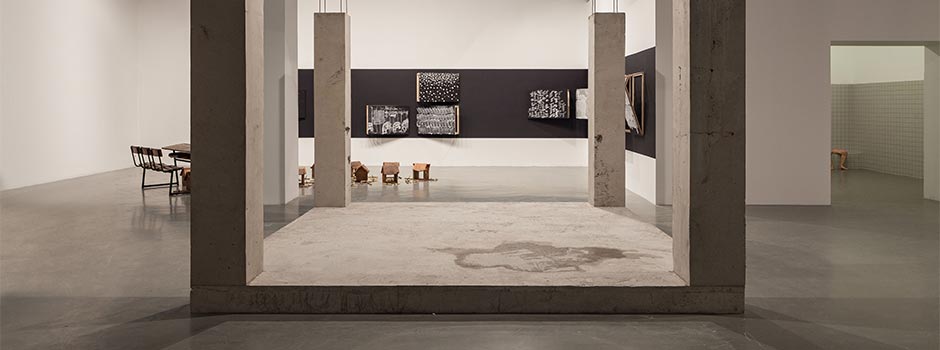
ART EVENT (SEP 16 - NOV 12, 2017) The 15th Istanbul Biennial - a good neighbour
Sep 26, 2017 Art Event

The 15th Istanbul Biennial, entitled a good neighbour and curated by artist duo Elmgreen & Dragset, opened to the public on September 16, 2017. Organised by the Istanbul Foundation for Culture and Arts (İKSV) since 1987, the 15th Istanbul Biennial brings together artworks by 56 artists from 32 countries, all addressing different notions of home, belonging and neighbourhood. Sponsored by Koç Holding, the 15th Istanbul Biennial can be visited free of charge until November 12, 2017.
The 15th Istanbul Biennial takes place in six nearby venues within walking distance: Galata Greek Primary School, Istanbul Modern, Pera Museum, ARK Kültür, Yoğunluk Atelier, and Küçük Mustafa Paşa Hammam. In addition to the two-month-long exhibition, the 15th Istanbul Biennial also features a Public Programme coordinated by artist and academic Zeyno Pekünlü that encompasses various events and discussions around the concepts of family and neighbourhood.
The 15th Istanbul Biennial’s opening week hosted more than 3000 guests from the international art scene, including critics, curators, museum and gallery directors, and media.
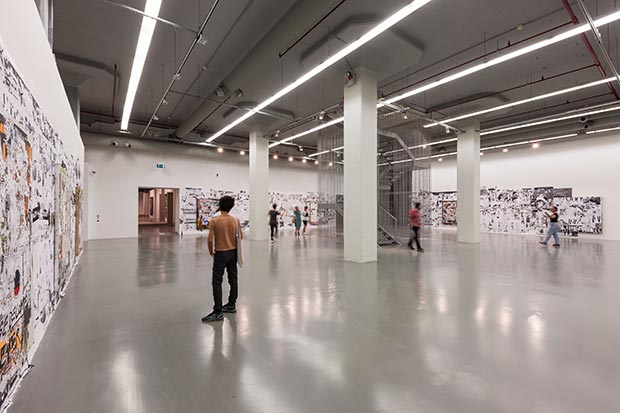 The 15th Istanbul Biennial, Photo by Sahir Ugur Eren / Courtesy of IKSV
The 15th Istanbul Biennial, Photo by Sahir Ugur Eren / Courtesy of IKSV
Instead of a curatorial statement, the curators have developed forty questions that are guiding the process of making the exhibition. These questions were first presented live in Istanbul by forty performers of different ages, genders and backgrounds in December last year, and can be found on the Biennial’s website. Some of these questions, such as “Is a good neighbour a stranger you don’t fear?†and “Is a good neighbour someone who reads the same newspaper as you?†are being used for an international billboard project presented in several cities around the world.
Bringing together a variety of artworks dealing with different notions of home and neighbourhood, the 15th Istanbul Biennial exhibitions is taking place at: Galata Greek Primary School, Istanbul Modern, Pera Museum, ARK Kültür, Yoğunluk Atelier, and Küçük Mustafa Paşa Hammam.
Artists: Heba Y. Amin, Mark Dion, Jonah Freeman & Justin Lowe, Kasia Fudakowski, Pedro Gómez-Egaña, Lungiswa Gqunta, Andrea Joyce Heimer, Morag Keil & Georgie Nettell, Olaf Metzel, Mahmoud Obaidi, Erkan Özgen, Leander Schönweger, Dan Stockholm, Ali Taptık, Bilal Yılmaz.
A neoclassical building located in Karaköy and in close proximity to Istanbul Modern, Galata Greek Primary School was one of the main educational locations for children of Greek descent in Istanbul for over a century. Due to a decrease in the Greek population of Istanbul in the second half of the twentieth century, the school officially closed its doors in 2007. A recurring venue of the Istanbul Biennial, the building has a special significance due to its legacy as a school, a place for learning and knowledge and a key institution in any residential neighbourhood. Fifteen artists are showing their work at the Galata Greek Primary School, each with an individual space, in classrooms, hallways, stairway landings, the former ballroom and the attic.
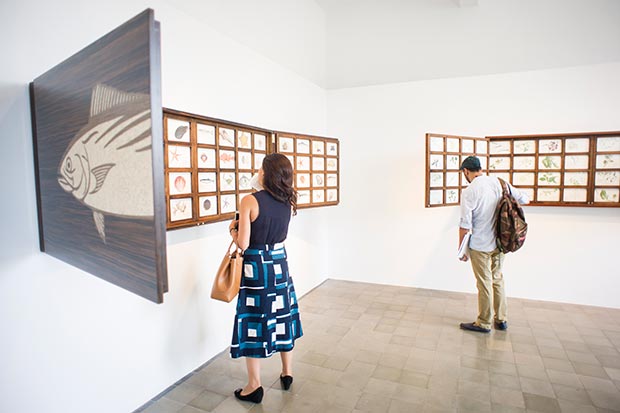 The 15th Istanbul Biennial, Photo by Ilgin Erarslan Yanmaz / Courtesy of IKSV
The 15th Istanbul Biennial, Photo by Ilgin Erarslan Yanmaz / Courtesy of IKSV
Artists: Adel Abdessemed, Volkan Aslan, Alper Aydın, Latifa Echakhch, Candeğer Furtun, Kim Heecheon, Mirak Jamal, Fernando Lanhas, Victor Leguy, Klara Lidén, Mahmoud Obaidi, Henrik Olesen, Lydia Ourahmane, Rayyane Tabet, Young-Jun Tak, Kaari Upson, Kemang Wa Lehulere, Yonamine, Xiao Yu.
Istanbul Modern is a former cargo warehouse that became an internationally renowned modern art museum following its initial use as a space for contemporary art at the 8th Istanbul Biennial in 2003. The building was designed by architect Sedad Hakkı Eldem between 1957 and 1958. The 15th Istanbul Biennial showcases nineteen artists’ projects within Istanbul Modern’s open-plan ground floor. Currently, the harbour area around the museum is under substantial transformation, and issues around urban development are reflected upon in several of the artworks displayed. The museum’s collection of Turkish and international modern and contemporary art is on permanent display on the second floor.
Artists: Adel Abdessemed, Monica Bonvicini, Louise Bourgeois, Njideka Akunyili Crosby, Alejandro Almanza Pereda, Berlinde De Bruyckere, Vajiko Chachkhiani, Gözde İlkin, Liliana Maresca, Lee Miller, Aude Pariset, Sim Chi Yin, Dayanita Singh, Tatiana Trouvé, Tsang Kin-Wah, Andra Ursuta, Fred Wilson.
Pera Museum was originally built by architect Achille Manoussos as Hotel Bristol in 1893. Suna and İnan Kıraç Foundation founded the Pera Museum after the neoclassical building’s renovation in 2005. Located just off İstiklal Caddesi, this private foundation museum has three large collections: Orientalist Paintings, Anatolian Weights and Measures, and Kütahya Tiles and Ceramics. The 15th Istanbul Biennial presents work by sixteen artists on the top three floors of the museum, with two additional works displayed within the museum’s Orientalist Painting collection. The museum’s curatorial team has put together a film programme responding to the Biennial’s title –a good neighbour– which is screened at scheduled times in the auditorium in the museum’s basement. Parts of the Biennial’s public programme take place in collaboration with the educational team of Pera Museum.
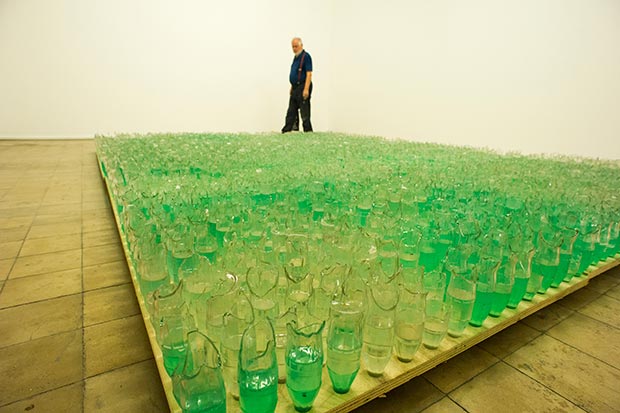 The 15th Istanbul Biennial, Photo by Ilgin Erarslan Yanmaz / Courtesy of IKSV
The 15th Istanbul Biennial, Photo by Ilgin Erarslan Yanmaz / Courtesy of IKSV
Artist: Mahmoud Khaled
ARK Kültür is located close to Istanbul Modern and Galata Greek Primary School, was originally built as a family home. The house has been inhabited by various different families throughout the decades. During the 1970s and 1980s, an Italian antique dealer transformed the building into an eclectic, ornate living space, but the house was redone in Bauhaus style in 2008 by its current owner, the architect Gülfem Köseoğlu. She also converted the building into an exhibition and cultural space. ARK Kültür displays a single artist’s work over all three floors, in the style of a fictional ‘house museum’.
Artist: YoÄŸunluk
As part of the 15th Istanbul Biennial, a participating local artist collective has redesigned their atelier, a former apartment in the BeyoÄŸlu neighbourhood, close to Pera Museum. YoÄŸunluk Atelier is situated on the fourth floor of a building on a busy restaurant street, and welcomes small groups of viewers on a timed viewing schedule due to the scale and the dimly lit nature of the site-specific installation.
Artists: Monica Bonvicini, Stephen G. Rhodes, Tuğçe Tuna.
Küçük Mustafa Paşa Hammam is located in the Fatih residential neighbourhood across the Golden Horn. While it is the site furthest away from the other venues, it remains within walking distance. Constructed in 1477, the disused hammam is one of the oldest Turkish baths in Istanbul and reflects some of the key traditional features and social structures of the Ottoman period. While the larger ‘male’ section of the hammam was a site for the 14th Istanbul Biennial, the recently renovated ‘female’ section is this year used as an exhibition space for the first time. Two artists have worked specifically with the interior of each of their sections, and a specially developed dance performance takes place at scheduled times within the ‘male’ part of the hammam.
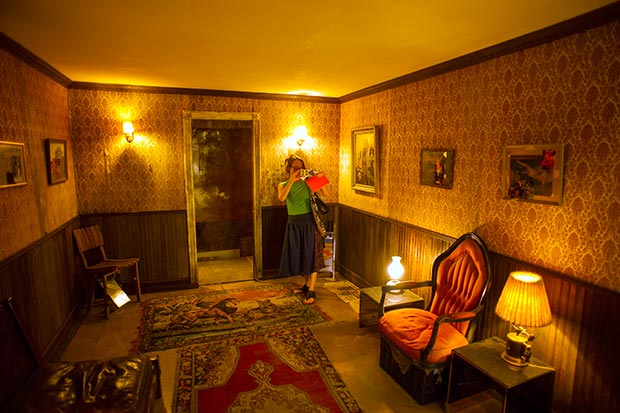 The 15th Istanbul Biennial, Photo by Ilgin Erarslan Yanmaz / Courtesy of IKSV
The 15th Istanbul Biennial, Photo by Ilgin Erarslan Yanmaz / Courtesy of IKSV
“On your way into Istanbul Modern, which is currently encroached by new developments under construction, you pass the freshly ploughed furrows in a field of cement. If you’re early, you might catch two Chinese farmers and their donkey. Upon entering the museum, you pass under a hitewashed 24-square-metre studio apartment turned upside down. Then you move through murals of angry demonstrators – the murals already halfway peeling off and lying like rubble on the floor. Construction fences are blocking your path, but you find your way beyond them, through pillaged pillars of historical buildings and the foundations of new ones. A bulldozer blade has pushed the tender trunks of young trees into a corner, while nine sculptural men are sitting in a tiled room, legs spread wide apart, taking their space, taking their time: is it Turkey and its eight neighbours? A child has made drawings of weapons from different countries he has lived in, and on sixteen surrounding blackboards, the lines of chalk account for nations that no longer exist.
You cross the street to Galata Greek Primary School: in the assembly hall, performers are slowly pulling apart a domestic setting. You take the big staircase up, and on each landing, a scene from Istanbul appears; one is an image of dogs resting behind a statue of Ataturk, as he gazes into the horizon over a corrugated metal fence. The same sort of metal that encapsulates you after you pass through a revolving door on the second floor. Next door, you can hear the sound of migrating birds. One floor up, you find a science lab for urban nature; to the right, a science lab for urban future (both in decline). Moving on up, a Syrian boy – unable to speak – is miming the horrors of a homestead under siege. Dodge another fence, and a lawn made of broken bottles lies before you; the faint smell of petroleum reaches your nostrils.
 The 15th Istanbul Biennial, Photo by Sahir Ugur Eren / Courtesy of IKSV
The 15th Istanbul Biennial, Photo by Sahir Ugur Eren / Courtesy of IKSV
When you take a walk up the hill to ARK Kültür, there’s a museum dedicated to an unknown crying man. A small house museum, celebrating that which is not heroic. You cross Istiklal, Istanbul’s battered pedestrian central vein, to reach Pera Museum, and in the midst of its collection of Ottoman paintings, you see one half-covered in concrete, exploded onto the crimson red wall behind. On the third floor, a carved African figure is trapped in a birdcage, flanked by colourless flags. Around the corner, a woman is looking back at you from Hitler’s study on the day he died. Go all the way to the top, and a grandmother’s parlour quietly sums up a life lived in presumed peace, while the word ‘fear’ snakes its way along the floor next door. Among the many restaurants in Asmalı Mescit street, you find Yoğunluk’s atelier on the fourth floor of an apartment building. Once inside, you let the small glimpses of light guide you through the darkness as you listen to the neighbours chatter in Greek. They left long ago.
A banner in German welcomes you at Küçük Mustafa Paşa Hammam, and a tower of debris invites you to stay and go away simultaneously. When venturing into the smaller rooms, you are met by rusty kiddie rides gone wild, violating heaps of hapless rubber dinghies. You go around to the men’s section, and take a look in the large mirror: it spells the word ‘guilt’.
The 15th edition of the Istanbul Biennial presents multiple artistic practices, which together become a tribute to diversity. Historical art positions and emerging ones compliment each other and offer a transhistorical continuity. Of the 56 participating artists, 30 have made new projects for the Biennial. a good neighbour can be experienced as an experiment in co-existence. Divergent and sometimes even conflicting statements exist side by side – for a while, they become neighbours – and function together by encouraging dialogue, reflection and continued discussion.â€
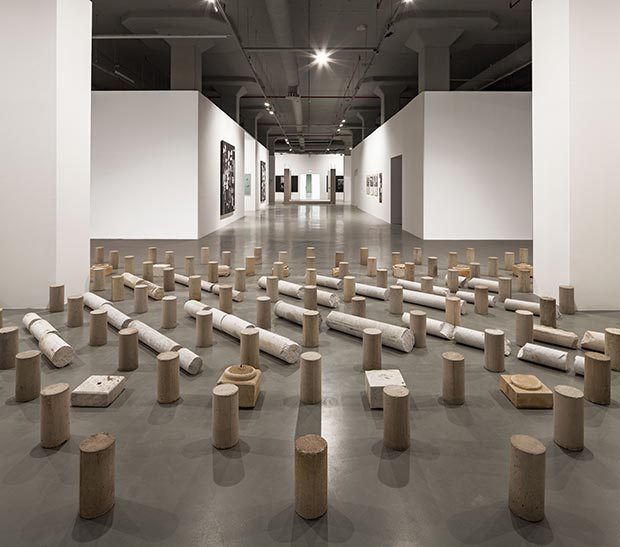 The 15th Istanbul Biennial, Photo by Sahir Ugur Eren / Courtesy of IKSV
The 15th Istanbul Biennial, Photo by Sahir Ugur Eren / Courtesy of IKSV
This year, the Istanbul Biennial spreads across the streets of Istanbul and the world in addition to the six venues. In anticipation of the exhibition, the 15th Istanbul Biennial also launched an International Billboard Project to share the theme of a good neighbour in different cities around the world. Through collaborations with cultural institutions worldwide, the International Billboard Project, designed by Rupert Smyth displays a selection of photographs by artist Lukas Wassmann, which capture unexpected encounters paired with questions asking what makes a good neighbour. Host cities include Moscow (Russia), Sydney (Australia), Milan (Italy), Ljubljana (Slovenia), Armagh, Ballynahinch, Belfast, Downpatrick and Newry (Northern Ireland), Southampton, Liverpool and Manchester (UK), Calgary (Canada), Plovidv (Bulgaria), Chicago (USA), Auckland (New Zealand), Dhaka (Singapore), Seoul and Gwangju (South Korea). The project will continue until the end of 2017.
 a good neighbour, international billboard project, Manchester UK, 2017, Photo by Rob Battersby / Courtesy of IKSV
a good neighbour, international billboard project, Manchester UK, 2017, Photo by Rob Battersby / Courtesy of IKSV
One of the works on display at public spaces at the 15th Istanbul Biennial belongs to Burçak Bingöl, an artist known for using ceramics and ornamentation in her works. In her series, Follower, the artist makes a critical interpretation of the surveillance culture of our day by ornamenting the surveillance cameras, which have gradually become one of the common sights of cities in the last ten years, with plant patterns she collected from Beyoğlu. Bingöl’s cameras can be seen during the biennial at over twenty locations including Kumbaracı 50, Pera Museum, Şimdi Café, LeBon Patisserie, Istanbul Modern. The artist Ugo Rondinone also participates in the 15th Istanbul Biennial with his neon sculpture Where Do We Go From Here? from his Rainbow Poems series (2007–17), which is an adaptation of his work first shown at the 6th Istanbul Biennial (1999) in Taksim Square. The new outdoor piece will be placed on the façade of the Mustafa Kemal Cultural Centre, a hub for art, business and cultural production near the Fatih Sultan Mehmet Bridge.
In addition to the two-month-long exhibition, the 15th Istanbul Biennial also features a Public Programme coordinated by artist Zeyno Pekünlü that encompasses a variety of events and discussions related to the concept of a good neighbour.
Click for more details on the 15th Istanbul Biennial’s Public Programme
Comments
Add a comment